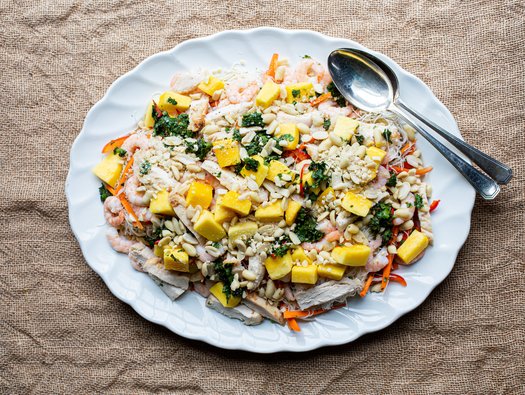Prawn and chicken noodles with mango

A light and versatile dish, low in potassium and phosphate, and high in protein, that can be served warm or cold.

A light and versatile dish, low in potassium and phosphate, and high in protein, that can be served warm or cold.
225g pack instant rice noodles
1 carrot, peeled and chopped into matchsticks
1 red pepper, thinly sliced
Juice of 2 limes
2 tablespoons reduced-salt soy sauce
1 tablespoon rice wine vinegar
1 red chilli, sliced
30g pack fresh coriander, chopped
30g pack fresh mint, leaves chopped
200g chopped mango
220g cooked prawns
200g cooked chicken breast, sliced into bite-sized pieces
90g unsalted peanuts, crushed
Put the noodles in a large heatproof bowl and cover with boiling water. Leave to stand for 1 minute, then start to tease them apart with forks. After another minute or two, the noodles will be cooked. Drain in a large sieve, rinse with cold water, then drain well. Tip the noodles into a large bowl and add the carrot and red pepper strips.
Mix the lime juice, reduced-salt soy sauce, chilli slices, coriander and mint leaves together in a jug. Pour half of the dressing over the noodles, carrot and pepper, then toss together.
Arrange the noodle mixture onto a large serving plate, then top with the prawns, chicken and mango, ensuring an even distribution of all the elements. Finish off the dressing by adding the rice wine vinegar to the remaining dressing in the jug, then drizzle it over the plate. Scatter over the crushed peanuts and serve.
The rice noodles are the main source of carbohydrate in this recipe, and the value has been provided for those who have been trained in insulin adjustment.
This recipe is low in potassium, when following the quantities in the ingredients, and the serving sizes. Therefore, it is suitable for those advised to reduce potassium in their diet.
This recipe is also low in phosphate, however it does contain some phosphate, mainly provided by the prawns, chicken and nuts, therefore if you have been prescribed a phosphate binder you should take as directed.
This recipe is high in protein, therefore suitable for those advised to eat more protein, such as those receiving dialysis.
Prawns are the expensive part of this dish, therefore you could reduce the cost by replacing the prawns with more cooked sliced chicken.
Use a gluten-free soy sauce.
Replace the prawns and chicken with tofu.
Although salt has not been added, and a reduced-salt soy sauce has been used, this recipe is not low in salt. This is because prawns are naturally salty and reduced salt soy sauce will still contain a high amount of salt. To lower the salt, consider replacing all or some of the prawns with an equal quantity of cooked chicken, or drained tinned chickpeas.
Once cooked and cooled, this recipe can be stored in an airtight container in the fridge. Use within 2 days. If eating this dish cold the following day, ensure it has been stored safely.
By giving us your email address, you're giving us permission to send you the latest news from Kidney Care UK. Further information about how we protect and use your personal data is available in our Privacy policy. If you would like to change the way we communicate with you at any time please email [email protected]. You can unsubscribe at any time by using the link at the bottom of every email we send.